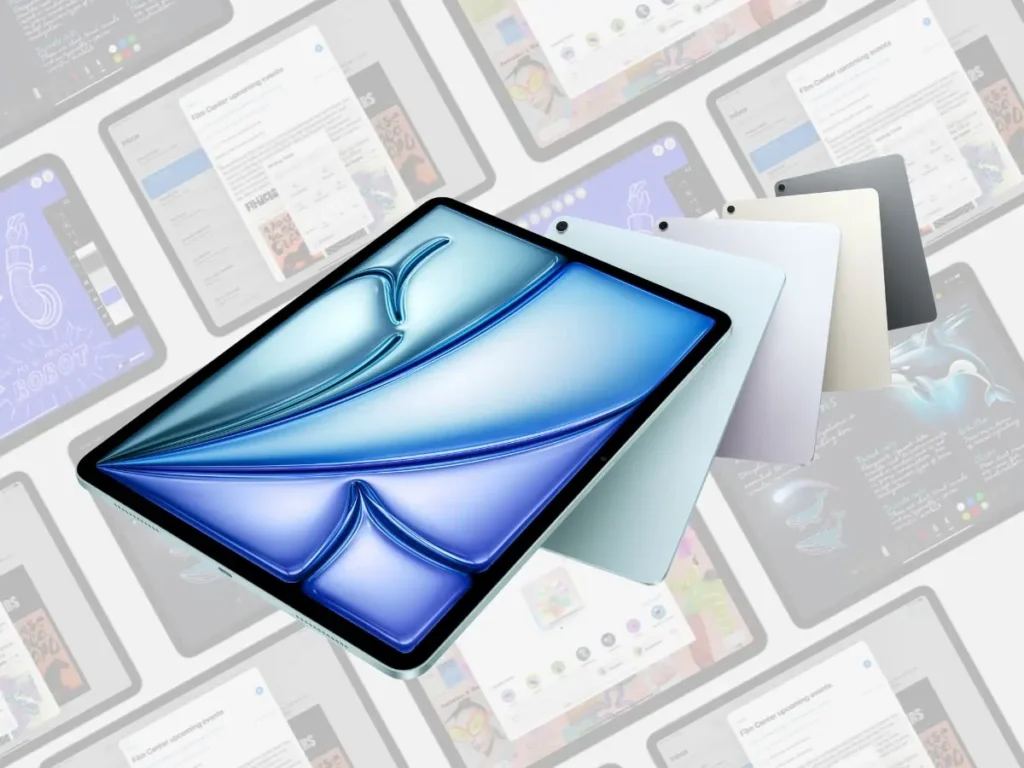Picture this: you’re enjoying your morning coffee while scrolling through your favorite social media feed—suddenly, your device is racing through it faster than you can take a sip. Before you know it, without even blinking, your device is seamlessly at work—swift, efficient, and almost telepathic.
What drives this smooth performance? The latest Apple device, powered by the M4 chip, was unveiled on May 7, 2024, and aims to enhance your daily experience seamlessly. The M4 chip revolutionizes performance with higher speeds, greater energy efficiency, and features that are set to transform all Apple products. Before exploring these advancements, let’s first go over the pricing and major updates to the new MacBook Pro.
The base price for the new MacBook Pro is USD 1599.00 for the 14-inch model, which comes with a 10-core CPU, 10-core GPU, 16GB of Unified Memory, and 512GB SSD storage. If you’re looking for a bigger display and better performance, the 16-inch MacBook Pro, which includes the M4 Pro Chip as standard, starts at USD 2,499.00.
This is remarkable, given the enhancements like increased power, Apple Intelligence, Thunderbolt, a new nano-texture display that minimizes glare, a 12MP Center-Stage Camera, and extended battery life of up to 24 hours—ideal for long work sessions or travel. Enhanced cooling keeps everything operating smoothly, even under pressure, and the seamless integration with macOS makes the MacBook Pro feel ready for any challenge you present.
CHECK OUT: Is Apple Ready to Compete in the Gaming World?

The Apple M4 chip represents a major leap in computing power, delivering enhanced speeds, better energy efficiency, and innovative features that will shape the future of Apple products. Apple’s custom silicon has consistently progressed with every version, and the M4 continues this trend. It caters to all users—whether you’re a professional handling intensive applications or just seeking a smooth, responsive experience for daily tasks.
What makes the M4 remarkable? This chip is built on advanced architecture that redefines the capabilities of Apple silicon. It’s rumored that the M4 utilizes a refined 3nm fabrication process, leading to improved performance and efficiency. With an increased number of transistors and optimized thermal management, Apple has managed to enhance speed and smoothness while preserving battery life—a perfect balance of power and portability.
Key Highlights of M4:
- Improved Core Architecture: The M4 is expected to feature additional CPU and GPU cores, which will significantly improve multitasking and graphics performance.
- Advanced Neural Engine: Designed to handle complex AI and machine learning tasks faster and more accurately.
- Memory and Storage: Increased unified memory support and higher bandwidth make the M4 ideal for handling resource-intensive applications.

The Apple M4 chip promises speed—and it truly delivers in the most essential areas. For example, tasks like image processing in Affinity Photo are now as much as 7 times faster than the 13-inch MacBook Pro with a Core i7 and 1.8 times quicker than the M1.
If you create 3D renderings in Blender, the M4 offers impressive performance—delivering speed enhancements of up to 10.9 times compared to the Core i7 and 3.4 times faster than the M1. For video editors utilizing Adobe Premiere Pro, scene edit detection now functions up to 9.8 times faster than the Core i7 and 1.7 times quicker than the M1. In summary, whether you’re editing high-resolution images, crafting 3D creations, or editing videos, the M4 efficiently manages demanding tasks, giving you more time for what truly matters.
Apple embarked on its custom silicon journey in 2020 with the M1, an innovation that merged exceptional performance with energy efficiency. As Apple’s first ARM-based chip for Macs, it laid the groundwork for future developments.
The M1 Pro, Max, and Ultra elevated performance for power users, whereas the M2 enhanced speed and intelligence with better CPU, GPU, and memory features. Following this, the M3 launched with 3nm architecture, offering greater speed and efficiency while conserving power.
The M4 now takes performance to new heights. It’s not just about impressive specs; it’s about real-world performance. Whether you’re editing 4K videos, compiling extensive code projects, or gaming at high settings, the M4 handles it all with ease. Its upgraded CPU and GPU deliver quicker rendering, smoother multitasking, and stunning graphics. Early tests suggest that the M4 operates 30% faster than the M3 while using no extra energy.

For creative professionals, the M4 is a formidable tool. Whether you’re editing 4K videos in Final Cut Pro, designing with the Adobe Suite, or mixing tracks in Logic Pro, performance is quicker and more seamless. Render times are shorter, previews appear instantly, and multitasking is effortless, enabling you to focus on creation instead of waiting. Developers will also reap the rewards of these enhancements, experiencing faster compile times that streamline workflows and alleviate the pressure of tight deadlines.
We shouldn’t overlook gamers and everyday users. The M4’s enhanced GPU provides console-quality graphics and seamless gameplay, along with improved app responsiveness and multitasking. It caters to all. Whether you’re gaming, streaming, or transitioning between work and leisure, the M4 operates effortlessly, making your device feel quicker, more intelligent, and prepared for any task.
What has everyone buzzing (myself included) is Apple Intelligence, powered by the M4 chip, which elevates the Mac experience to a whole new level. Everyday tasks feel smarter, faster, and stress-free. Whether you’re fine-tuning text with system-wide Writing Tools, creating custom emojis with Genmoji, or experimenting with visuals in Image Playground, everything feels smoother and more intuitive.
Siri also receives a notable upgrade—effortlessly enabling you to switch between speaking and typing, answer questions, and manage tasks across your Mac. Starting this December, you’ll even be able to access ChatGPT directly, with no additional tools required.
Key Features:
- Systemwide Writing Tools: Rewrite, proofread, and summarize text anywhere you type.
- Image Playground: Create fun, original visuals effortlessly.
- Genmoji: Generate custom emojis in seconds.
- Upgraded Siri: Move between spoken and typed requests with smarter responses and systemwide actions.
- ChatGPT Integration: Access AI expertise directly within Siri and Writing Tools.
- On-Device AI Processing: Faster voice recognition, predictive text, and photo enhancements powered by the M4 chip.
| Features | Macbook Pro 14-Inch M4 | MacBook Air 15-Inch M3 |
| Chip Set | Apple M4 | Apple M3 |
| Performance | Superior for demanding applications, heavy multitasking, and pro-level tasks | Great for everyday tasks, media consumption, and light multitasking |
| Geekbench 6 Single-Core | Approx. 2800 | Approx. 2200 |
| Geekbench 6 Multi-Core | Approx. 13,000 | Approx. 8400 |
| Cinebench R23 Multi-Core | Around 13,800 | Around 8500 |
| Graphics | Apple GPU with up to 30 cores | Apple GPU with 10 cores |
| Display | 14″ or 16″ Liquid Retina XDR, 1000 nits sustained, 1600 nits peak for HDR | 13.6-inch Liquid Retina, 500 nits |
| ProMotion (120Hz) | Yes | No |
| Ports | 3x Thunderbolt 5, HDMI, SDXC, MagSafe | 2x Thunderbolt 3, MagSafe |
| External Display Support | Up to 2x 6K displays, 1x 8K display via HDMI | 2x external displays, up to 6K at 60Hz |
| Battery Life | Up to 17 hours | Up to 18 hours |
Some commentators argue that the 14-inch MacBook Pro with M4 isn’t a substantial upgrade or worth opting for over the 15-inch MacBook Air with M3, but the results suggest a different narrative.
Both models are priced identically at USD 1,599.00, so the choice is in terms of performance and features. While the MacBook Air offers a larger screen, the MacBook Pro outshines it in key areas: superior display quality, longer battery life, an enhanced keyboard, and significantly better performance powered by the M4 chip.
While not everyone requires the extra power of the M4 chip or prefers the Pro’s compact design, the MacBook Pro 14-inch M4 stands out as the more intelligent choice for those who value performance, portability, and overall worth. It provides enhanced efficiency, a clearer display, and unparalleled power for the same price.

Here’s a complete list of pricing for every make and model in the lineup:
MacBook Pro 14-inch with M4:
- M4 14-inch MacBook Pro (10-Core CPU, 10-Core GPU, 16GB Unified Memory, 512GB SSD Storage): USD 1,599.00
- M4 14-inch MacBook Pro (10-Core CPU, 10-Core GPU, 16GB Unified Memory, 1TB SSD Storage): USD 1,799.00
- M4 14-inch MacBook Pro (10-Core CPU, 10-Core GPU, 24GB Unified Memory, 1TB SSD Storage): USD 1,999.00
MacBook Pro 14-inch with M4 Pro:
- M4 Pro 14-inch MacBook Pro (12-core CPU, 16-core GPU, 24GB Unified Memory, 512GB SSD Storage): USD 1,999.00
- M4 Pro 14-inch MacBook Pro (14-core CPU, 20-core GPU, 24GB Unified Memory, 1TB SSD Storage): USD 2,399.00
MacBook Pro 14-inch with M4 Max
- M4 Max 14-inch MacBook Pro (14-core CPU, 32-core GPU, 36GB Unified Memory, 1TB SSD Storage): USD 3,199.00
MacBook Pro 16-inch with M4 Pro:
- M4 Pro 16-inch MacBook Pro (14-core CPU, 20-core GPU, 24GB Unified Memory, 512GB SSD Storage): USD 2,499.00
- M4 Pro 16-inch MacBook Pro (14-core CPU, 20-core GPU, 48GB Unified Memory, 512GB SSD Storage): USD 2,899.00
MacBook Pro 16-inch with M4 Max:
- M4 Max 16-inch MacBook Pro (14-core CPU, 32-core GPU, 36GB Unified Memory, 1TB SSD Storage): $3,499.00
- M4 Max 16-inch MacBook Pro (16-core CPU, 40-core GPU, 48GB Unified Memory, 1TB SSD Storage): USD 3,999.00
If you’re ready to max out the 16-inch MacBook Pro with M4 Max, hold onto your wallet—it’s quite the ride. The base model starts at USD 3,999 with a 16-core CPU, 40-core GPU, 48GB Unified Memory, and 1TB SSD Storage, but the upgrades are where things get spicy. Want the Nano-Texture Display? That’ll set you back USD 100. Need 128GB Unified Memory? That’s another USD 1,000. And if you’re feeling extra bold, crank up the storage to a whopping 8TB SSD for USD 2,200. Fully loaded, you’re looking at a cool USD 7,848—the cost of a small car or, in tech flex terms, a laptop that might outlast your following three vehicles. For those living on the edge—or just with deep pockets—it’s the ultimate power move.














